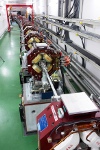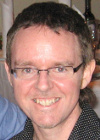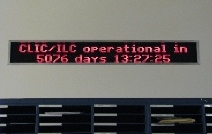From SLAC Today: A Flight Simulator for the World's Smallest Beam

The Accelerator Test Facility 2 in Japan uses a 50-meter series of magnets to focus its electron beam. (Photo by N. Toge, KEK) |
Commissioning has begun at the Japan-based Accelerator Test Facility 2, a major technology test bed for future accelerators, including the proposed
International Linear Collider, or ILC. During the two-year commissioning process, SLAC
National Accelerator Laboratory physicists are shuttling back and forth to KEK,
the high-energy accelerator lab in Tsukuba, to join an
international team of
scientists working around the clock to get the accelerator's final focus system up and running. When fully commissioned, this system will squeeze the facility's electron beam down to a slender ribbon just 35 nanometers thick—the narrowest beam of particles ever achieved.
Read more...
-- Lauren Schenkman, SLAC Today |
 |
|
|
 |
Upcoming meetings, conferences, workshops
Joint ACFA Physics and Detector Workshop and GDE Meeting on International Linear Collider
(TILC09)
Tsukuba, Japan
17-21 April 2009
Particle Accelerator Conference 2009 (PAC09)
Vancouver, Canada
4-8 May 2009
11th European Symposium on Semiconductor Detectors
Wildbad Kreuth Conference Center, Bavaria, Germany
7-11 June 2009
ILC-CLIC LET Beam Dynamics Workshop at CERN
CERN, Switzerland
23-25 June 2009
Upcoming schools
Spring School on Strings, Cosmology and Particles (SSSCP2009)
Belgrade, Serbia
31 March - 4 April 2009
Terascale Monte Carlo school 2009
DESY Hamburg, Germany
20-24 April 2009
School on Calorimetry at the International Linear Collider
China Center of Advanced Science and Technology, Beijing, China
22-26 April 2009
|
|
|
GDE Meetings calendar
View complete ILC calendar
|
|
|
 |
ILC bloggers join Quantum Diaries
“This is going to be a new, hopefully interesting and enjoyable experience,” says Frank Simon, in his opening post.

|

|
| Tony Hartin (left) and Frank Simon (right), ILC Bloggers for 'Quantum Diaries'. Credit: interactions.org |
One is Australian, the other German. Both are physicist willing to share their everyday lives as particle physicists working on the ILC project. Together with eight other diarists, they joined the new Quantum Diaries blog launched on 31 March 2009.
Read more...
-- Perrine Royole-Degieux |
 |
|
|
 |
What do they know that we don't?

Scientists at the Dutch national lab Nikhef seem to know more about the future of particle physics than they let on... this countdown was spotted at a coffee break during a recent meeting there. It's no April fool's joke, but it isn't quite accurate either... “We used to count down to the LHC start-up,” explains Nikhef communication officer Gabby Zegers. “Now that that has happened we needed a new date to count down to, and we randomly set the ILC starting date to 2 February 2023.” Who knows, maybe they do know more than the ILC management...
|
 |
|
|
 |
From Fermilab Today's April Fool's issue
1 April 2009
Student discovers flaw in Large Hadron Collider
Yurkewicz, a student at l'Espace de vie enfantine (EVE) in Meyrin, Switzerland, said he had been going over the analysis of the calculations as his class put on their jackets for outdoor activity period.
Particles attempt lab takeover
One possibility under investigation is that a group of neutrinos passed by security cameras undetected.
Read more... |
|
From resonaances.blogspot.com
1 April 2009
No Higgs particle after all?
Yesterday at CERN Peter Higgs gave a seminar whose message was really shocking. No more no less, Higgs demonstrated that the famous particle that carries his name cannot exist!
Read more... |
|
From Fermilab Today
31 March 2009
New group supports SCRF technology industrialization
A new organization will foster partnerships between industry and government-funded organizations working on advanced accelerator programs.
Read more... |
|
From Les Echos
30 March 2009
Un masque du boson de Higgs tombe
L'accélérateur de particules américain du Fermilab vient d'affiner le portrait-robot du boson de Higgs
Read more... (in French) |
|
From Examiner.com
27 March 2009
Will dark energy cause the end of the universe?
They have come up with three possible dark energy candidates. Each produces a different value equation (...), which in turn dictates how the universe will end according to which is the actual value of dark energy.
Read more... |
|
|
 |
Neutrinos in Venice

The optical telescope gave us a new way to look at the sky |
Last month I had the pleasure of participating in the "XIII International Workshop on Neutrino Telescopes" at the "Istituto Veneto di Scienze, Lettere ed Arti" in Venice Italy. This workshop, inspired and run by Professor Milla Baldo Ceolin (Padova University), has become an institution in neutrino physics. The meeting is based on review talks followed by extensive discussions and the programme broadly covers topics related to neutrino physics, astrophysics and cosmology, singling out the most interesting current results and problems. This year’s meeting was especially interesting to me in how it demonstrated the relationships between accelerator and non-accelerator physics and how much closer astrophysics is becoming to particle physics.
Read more...
-- Barry Barish
Director's Corner Archive |
 |
|
|
 |
Fourth International Accelerator School for Linear Colliders
The Fourth International Accelerator School for Linear Colliders (2009 LC School) will be held from 7-18 September 2009 at Hotel Jixian, Huairou, near Beijing, China under the auspices of the GDE, ILCSC and ICFA Beam Dynamics Panel. The Institute of High Energy Physics (IHEP) will be the host institution. The school will take a maximum of 70 students from around the world. Students will receive financial aid including travel (airfare, lodging, meals and local transportation, full or partial). Only online application will be accepted. The deadline is June 1, 2009.
Detailed information can be found online:
www.linearcollider.org/school/2009/
arXiv preprints
0903.4991
Silicon Tracking DAQ
0903.4978
Single Higgs-boson production through gamma-gamma scattering within the general 2HDM
0903.4777
Probing the Z' sector of the minimal B - L model at future Linear Colliders in the e+ e-→ μ+ μ- process
0903.4673
A new 130nm F.E readout chip for microstrip detectors
0903.4606
e+ e-→ t anti-t H including decays: on the size of background contributions
0903.4361
Overview of the SiLC R&D Activities
0903.4135
MC@NLO for the hadronic decay of Higgs bosons in associated production with vector bosons
|
|

